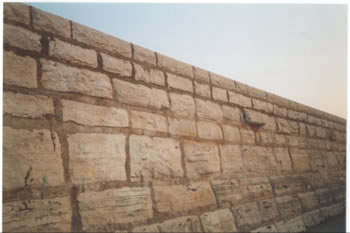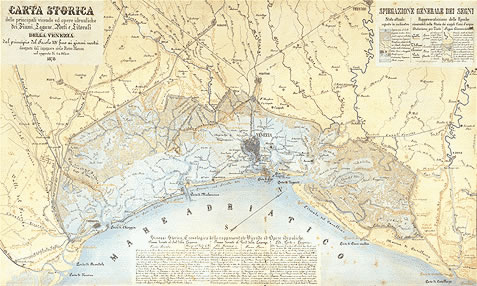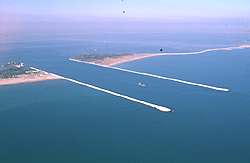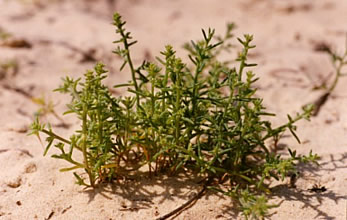Littoral
Introduction
It is the area of the Lido facing the sea. The "Lidi"
are strips of land separating the lagoon from the sea and stretching for
about 50 km: from the mouth of the Brenta to that of the Sile (From "I
litorali sabbiosi del lungomare veneziano -part 2").
They are formed by a belt of high dunes made up of alluvial materials
deposited mainly by two rivers: the Tagliamento and the Piave. The current,
which in the Northern Adriatic Sea has a direction from northeast to southwest,
has made these alluvial deposits parallel to the coast.
6000 years ago this zone used to belong to Veneto's plain and successively,
with the rising of the sea level (eustacy)
and the lowering of the soil (subsidence),
it gave rise to longshore bars. Veneto's old plain, which, until 18.000
years ago reached the city of Pescara (from "La Laguna: Origine ed
Evoluzione" in "La Laguna di Venezia") is made up of "caranto",
a layer of very compact mineralised clay which forms the natural bed of
the lagoon. On this lagoon bed the Venetians have set the stakes that
support the buildings of the city.
The wide marshland, which had been confined behind that line, was initially
a fresh water lagoon, but periodic breakthroughs of the tide let sea water
enter, turning it into a brackish water lagoon (from "Guida alla
natura nella laguna di Venezia - Itinerari, storia e informazioni naturalistiche",
1996).
These processes are still active and littorals are continuously involved
by constructive phenomena as the deposit of sandy material coming from
the sea (sedimentation)
and by destructive phenomena as marine and eolian erosion.
The aspect of the littorals has changed during the centuries not only
because of the natural evolution of this extremely dynamic environment,
but also because of continuous human intervention, as in the case of the
building of the "Murazzi", in the deflection of the tributaries
from the Lagoon, and successively in the realisation of jetties and groynes.
Human Interventions
Man's relationship with the lagoon has been constantly characterised
by interventions which began right from the time of the first settlings
in this environment.
Until the 15th century interventions were restricted to a limited number
of works of consolidation and embankment that did not modify the essential
characteristics of the original lagoon.
Major works which influenced and started to modify the natural dynamisms
began from the 18th century.
The first interventions date back to 1738, when the Republic of Venice
realised along the littorals of Malamocco, Pellestrina and Sottomarina
the so-called "Murazzi": sea defensive works made up of Istrian
stone and "pozzolana".
They are jetties whose aim was to create a barrier to prevent the sea
from attacking and eroding the banks.
The idea of building these defensive works was conceived in 1716 by Father
Vincenzo Coronelli. He sent the "Savi ed Esecutori alle Acque",
main office in charge of civilian public works, his innovative project,
in which he proposed to substitute the traditional sea defensive works
made up of oak trunks and filling material with a real staircase made
up of Istrian stone blocks.
But it was the Water, Rivers, and Lagoon supervisor Bernardino Zendrini
who carried out this project thanks to the employ of "pozzolana",
a recently discovered material, which solidifies when it is mixed to lime
and if it comes in touch with water. This way the Istrian stone blocks
"welded" with each other and made the "Murazzi" barrier
even more effective.
ne more intervention that modified the aspect and the dynamisms of the
lagoon was the deflection
of the lagoon tributaries. Because of the sediments coming
from the tributaries, which were not compensated by the erosive effect
of the sea currents, the natural evolution of the lagoon environment would
have meant its silting up.
The "Serenissima Republic" has always regarded the silting up
of the lagoon as a problem because of the negative effect it could have
had on the city of Venice, whose safety and prosperity were indissolubly
linked to the existence of the lagoon around the city.
The first interventions on water-courses were first performed in the 12th
century: the plain water-courses were embanked in order to limit the erosion
and the consequent transport of sediments to the lagoon. These works did
not bring the expected results and it was therefore decided to face the
problem radically deflecting the rivers that flew into the lagoon.
The first river to be deflected was the Brenta, whose course was moved
from Fusina to the sea in 1548. The silting up of the Lagoon was actually
slowed down, but at the same time both the erosion and the withdrawing
of the salt-marshes increased, a problem that has been discussed since
1600.
In the Lagoon there is still a well visible track of the old course of
the Brenta: the Grand Canal, an old lagoon tract of that river.
In 1896 the Brenta, because of the difficult downflow and the consequent
flooding caused by the winding course it was forced to follow to reach
the sea, was newly deviated in the Lagoon. However, in the following 40
years the increase in the silting process led to the definite decision
to deflect the river to the sea, in the bed of the Bacchiglione.
The Piave did not have such a troubled history as the Brenta had: it was
first deflected to Cortellazzo, then to Santa Margherita, but in 1862
it flooded and went back to hold the river bed that leads to Cortellazzo.
The Sile, being a resurgence river, has always
presented few problems of sediment transport and was deflected in 1680
in Piave's old river bed mainly for health problems.
The deflection of the tributaries to the sea caused the disappearance
of the marsh belt, which formed a peculiar and important avifauna environment
and to an increase in the level of the salinity
of the salt marshes and of the lagoon beds.
Freshwater environments are currently reduced to small portions in the
lagoon edge area and they are sometimes formed by artificial environments
as deserted clay mines later transformed into in marshlands (e.g. Cave
Gaggio).
During the 19th century interventions were carried out on fish farms building
fixed frame embankments and jetties: these modifications started a process
of substitution of lagoon environments with land environment. (From "
Le problematiche naturalistiche nella progettazione e gestione degli interventi
sulla Laguna”, 1997).
The jetties are hundreds of metres long and link the sea to the Lagoon
allowing the ebb and flow of the tide.
They were built during three subsequent phases starting from 1805 at the
Lagoon inlets of Malamocco, Lido and Chioggia in order to deepen the seabeds
hindering the natural silting up of the canals and in order to allow big
tonnage ships to enter the port of Venice.
By the narrowing of the section of the canals, the entrance speed of the
current increased and so did the eroding force acting on the beds, whose
depth indeed changed from the original 5-6 metres to the current 20 even
30 metres . This modified environment changed the natural current circultation
causing downstreman at each jetty a loss in the sandy material and upstream
an accumulation of the same material, as it can easily be observed comparing
San Nicolò's littorals at the Lido and the littorals of Punta Sabbioni
at the Cavallino.
Natural evolution
From what has been said so far it can be easily understood that littoral
environment is continuously evolving both from a morphological and a functional
point of view.
Besides the changes that have been taking place on wide spatial scales,
one can also notice the continuous evolution characterising the littoral
environment.
sea current in the shape of heaps of algae
and dead
phanerogamae, enable the vegetal and animal population to evolve
and settle in an environment which apprently seems so inhospitable and
without resources (from “Un ambiente naturale unico – Le spiagge
e le dune della penisola del Cavallino”, 1992).
Each vegetal and animal "presence" helps to create the right
environment for the settling of other organisms in a dynamic process of
close relations that takes place in a restricted belt stretching from
the seashore to the littoral wood.
The organisms living in this environment had to adapt to difficult life
conditions, adopting some devices enabling them to survive.
Some plants as the Russian thistle (Salsola
kali), try to reduce as much as possible potential water
losses due to transpiration by reducing the leaf surface exposed to sunbeams:
this way they can accumulate water in the tissues and employ it in case
of drought (From "Un ambiente naturale unico – Le spiagge e
le dune della penisola del Cavallino").
The plants in this environment have succulent
leaves to reduce the loss of water due to evaporation, a quick vital cycle
to exploit as much as possible the most favourable periods and an elevated
seed production to enable at least some individuals to take root (From
"Un ambiente naturale unico – Le spiagge e le dune della penisola
del Cavallino").
The plants suitable to live at some distance from the sea are grouped
in strips parallel to the seashore line forming vegetal
associations whose characteristics reflect the variations
of the environmental characteristics from the seashore to the most inland
environments.
The first plants that can be met moving away from the seawater are the
so-called "pioneer
plants", that means that they are the first plants to
colonise an inhospitable environment and that they prepare the soil for
more exigent species.
The sand transported by the wind and the materials brought by sea currents
are deposited at the basis of these plants, thanks to which the first
belt of dunes is made up (From "Un ambiente naturale unico –
Le spiagge e le dune della penisola del Cavallino").
|



